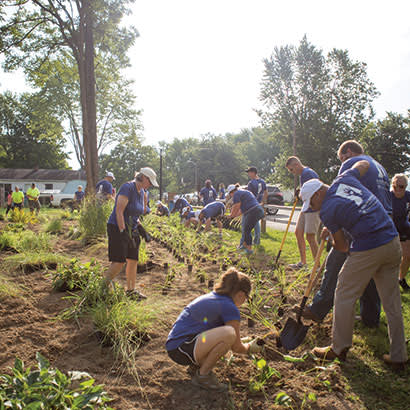
For an enhanced digital experience, read this story in the ezine.
As the coronavirus (COVID-19) pandemic puts a pause on work and social events, people are looking for creative ways to be physically active, to stay in touch with loved ones and to entertain themselves at home and away from others. Parks — especially neighborhood parks and nearby green spaces — have been essential for the safe enjoyment of the outdoors during the pandemic. Many people have a newfound appreciation for the community benefits provided by local park and recreation staff and facilities. This eye-opening realization has helped many people see the critical role community parks and the staff who work tirelessly to run them serve in solving social, health and environmental challenges. Now is the time to advocate for and adopt policies that support the advancement of “greener parks,” or those parks that address climate impacts through green infrastructure and advance equitable access to quality green spaces.
Greener Parks for the Greater Good
The benefits of greener parks are especially important for communities hit the hardest by natural disasters, most affected by air pollution and lacking access to quality parks due to years of disinvestment. How can greener parks really make a positive impact on people’s health, especially considering COVID-19 is at the center of every public health conversation? According to NRPA’s Parks, Green Infrastructure and Health literature review:
- Increased tree canopy is associated with decreased rates of obesity and obesity-related illnesses. Research shows that during March 2020, obesity was one of the highest occurring underlying health conditions for COVID-19 hospital admissions.
- Spending time in places with green features helps people recover from mental fatigue, which is especially important during these truly trying times. We often forget to take care of our mental state.
- Green infrastructure planning, development and maintenance create jobs for skilled workers. As we are thinking about how to restart our economies and get people back to work, consider supporting a movement toward green jobs.
- Well-managed green infrastructure in public places can grow trust and satisfaction community members have with local government, which increases over time as the assets stay well-managed. Because these parks play a crucial role in helping communities cope with the pandemic, community members will advocate for elected officials to prioritize the development and maintenance of public parks.
This health pandemic has put a spotlight on various social challenges that can be linked to shortcomings in our current political and economic systems. These systems continue to undervalue environmental services, such as those provided by greener parks, and shift the greatest burden of impact onto our most vulnerable populations. It isn’t the only solution, but equitable investment in greener parks provides exceptional returns to all and is unanimously supported by the public.
Using Parks as Opportunities for Change
Research shows that political systems often continue without significant change until there is a major shock that disrupts the flow. Although none of us wanted this ruthless pandemic to be the reason, it is undeniable that this is an extraordinary moment in history. We have an opportunity during this disruption to leverage a policy shift that prioritizes greener parks as critical infrastructure that simultaneously improves environmental conditions, provides safe spaces to foster healthy lifestyles, and promotes social and economic stability in a volatile world.
By prioritizing parks and green infrastructure as essential infrastructure, we can remove barriers to implementing greener parks, which will generate more jobs and support healthier lifestyles. Local leaders should collaborate across municipal agencies to invest in creating master plans and budgets that highlight equitably distributed and interconnected greener parks as a solution to health, environmental and social issues. This would aid in immediately putting people back to work — planning, designing and constructing shovel-ready park projects and addressing the maintenance backlog in parks after years of disinvestment.
This summer, NRPA is releasing a suite of resources aimed at equipping you with the tools and knowledge to promote and advocate for greener parks in your community, including a communications toolkit, policy action framework and advocacy toolkit. See the NRPA Greener Parks for Health webpage for more details.
Greener Parks
What do we mean by “greener parks?” Parks serve important functions for recreation and green space in communities, but incorporating green infrastructure into parks can help boost their overall benefit to communities through increased health, environmental, social and economic benefits.
Wende David is Senior Program Manager at NRPA. Jenny Cox is Conservation Program Manager at NRPA.

